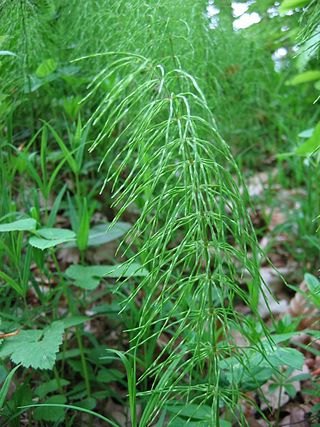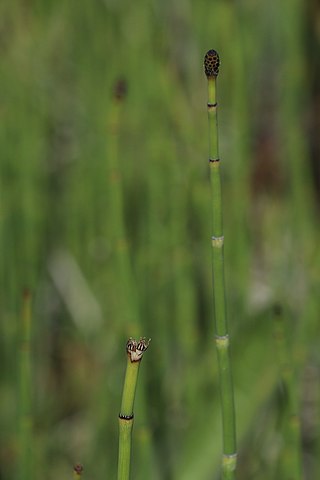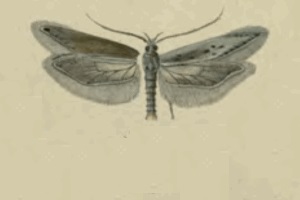
Equisetum is the only living genus in Equisetaceae, a family of vascular plants that reproduce by spores rather than seeds.

Equisetaceae, also known as the horsetail family, is a family of ferns and the only surviving family of the order Equisetales, with one surviving genus, Equisetum, comprising about twenty species.

Equisetales is an order of subclass Equisetidae with only one living family, Equisetaceae, containing the genus Equisetum (horsetails), as well as a variety of extinct groups, including the tree-like Calamitaceae.

Equisetum fluviatile, the water horsetail or swamp horsetail, is a vascular plant that commonly grows in dense colonies along freshwater shorelines or in shallow water in ponds, swamps, ditches, and other sluggish or still waters with mud bottoms. It is a perennial herbaceous species, growing 30–100 cm tall with erect dark green stems 2–8 mm in diameter, smooth, with about 10–30 fine ridges. At each joint, the stem has a whorl of tiny, black-tipped scale leaves 5–10 mm long. Many, but not all, stems also have whorls of short ascending and spreading branches 1–5 cm long, with the longest branches on the lower middle of the stem. The side branches are slender, dark green, and have 1–8 nodes with a whorl of five scale leaves at each node. The water horsetail has the largest central hollow of the horsetails, with 80% of the stem diameter typically being hollow.

Equisetidae is one of the four subclasses of Polypodiopsida (ferns), a group of vascular plants with a fossil record going back to the Devonian. They are commonly known as horsetails. They typically grow in wet areas, with whorls of needle-like branches radiating at regular intervals from a single vertical stem.
A strobilus is a structure present on many land plant species consisting of sporangia-bearing structures densely aggregated along a stem. Strobili are often called cones, but some botanists restrict the use of the term cone to the woody seed strobili of conifers. Strobili are characterized by a central axis surrounded by spirally arranged or decussate structures that may be modified leaves or modified stems.

Equisetum arvense, the field horsetail or common horsetail, is an herbaceous perennial plant in the Equisetidae (horsetails) sub-class, native throughout the arctic and temperate regions of the Northern Hemisphere. It has separate sterile non-reproductive and fertile spore-bearing stems growing from a perennial underground rhizomatous stem system. The fertile stems are produced in early spring and are non-photosynthetic, while the green sterile stems start to grow after the fertile stems have wilted and persist through the summer until the first autumn frosts. It is sometimes confused with mare's tail, Hippuris vulgaris.

Red Rocks (SSSI) is an area of sand dunes and reed beds at the mouth of the Dee Estuary and to the west of Hoylake on the Wirral Peninsula, England.

Equisetum palustre, the marsh horsetail, is a plant species belonging to the division of horsetails (Equisetopsida). It is widespread in cooler regions of North America and Eurasia.

Equisetum pratense, commonly known as meadow horsetail, shade horsetail or shady horsetail, is a widespread horsetail (Equisetophyta) fern. Shade horsetail can be commonly found in forests with tall trees or very thick foliage that can provide shade and tends to grow closer and thicker around streams, ponds and rivers. The specific epithet pratense is Latin, meaning pasture or meadow dwelling.

Equisetum telmateia, the great horsetail or northern giant horsetail, is a species of Equisetum (puzzlegrass) with an unusual distribution, with one subspecies native to Europe, western Asia and northwest Africa, and a second subspecies native to western North America. The North American subspecies is often simply but ambiguously called "giant horsetail", but that name may just as well refer to the Latin American Equisetum giganteum and Equisetum myriochaetum.

Equisetum laevigatum is a species of horsetail in the family Equisetaceae. It is known by the common names smooth horsetail and smooth scouring rush. This plant is native to much of North America except for northern Canada and southern Mexico. It is usually found in moist areas in sandy and gravelly substrates. It may be annual or perennial. It grows narrow green stems sometimes reaching heights exceeding 1.5 meters. The leaves at the nodes are small, scale-like brownish sheaths and there are occasionally small, spindly branches. The stems are topped with rounded cone-shaped sporangia.

Equisetum hyemale is a perennial herbaceous fern in the horsetail family Equisetaceae. It is a native plant throughout the Holarctic Kingdom, found in North America, Europe, and northern Asia.

Equisetum variegatum, commonly known as variegated horsetail or variegated scouring rush, is a species of vascular plant in the horsetail family Equisetaceae. It is native to the Northern Hemisphere where it has a circumpolar distribution.

Equisetum scirpoides Michx., Fl. Bor.-Amer. 2: 281 (1803). 2 n = 216.The smallest of the currently occurring representatives of the genus Equisetum (horsetail).

Amata fortunei, the white-spotted moth, is a moth of the family Erebidae. The species was first described by d'Orza in 1869. It is found in Japan, South Korea and Taiwan.
Equisetum thermale is an extinct horsetail species in the family Equisetaceae described from a group of whole plant fossils including rhizomes, stems, and leaves. The species is known from Middle to Late Jurassic sediments exposed in the province of Santa Cruz, Argentina. It is one of several extinct species placed in the living genus Equisetum.

Gnorimoschema herbichii is a moth in the family Gelechiidae. It was described by Nowicki in 1864. It is found in Portugal, Spain, France, the Netherlands, Germany, Denmark, Poland, Hungary, Romania, North Macedonia, the Baltic region, Norway, Finland, Ukraine and Russia. In the east, the range extends to Transbaikalia, Mongolia and Kamchatka. It is also found in North America, where it has been recorded from Alberta, Yukon, Manitoba and Ontario.

Equisetum × trachyodon is a nothospecies of Equisetum. Sometimes, it is considered as an individual species: Equisetum trachyodon.















